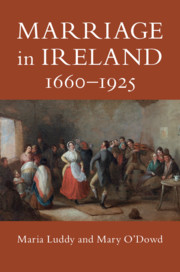Book contents
- Marriage in Ireland, 1660–1925
- Marriage in Ireland, 1660–1925
- Copyright page
- Dedication
- Contents
- Figures
- Illustrations
- Tables
- Acknowledgements
- Abbreviations
- Introduction
- Part I What Is a Marriage?
- Part II Ways to Marriage
- 3 Meeting and Matching with a Partner
- 4 Courtship Behaviour
- 5 Breach of Promise
- 6 Abductions
- Part III Happy Ever After?
- Part IV The Unmaking of Marriage
- Conclusion
- Select Bibliography
- Index
4 - Courtship Behaviour
from Part II - Ways to Marriage
Published online by Cambridge University Press: 04 June 2020
- Marriage in Ireland, 1660–1925
- Marriage in Ireland, 1660–1925
- Copyright page
- Dedication
- Contents
- Figures
- Illustrations
- Tables
- Acknowledgements
- Abbreviations
- Introduction
- Part I What Is a Marriage?
- Part II Ways to Marriage
- 3 Meeting and Matching with a Partner
- 4 Courtship Behaviour
- 5 Breach of Promise
- 6 Abductions
- Part III Happy Ever After?
- Part IV The Unmaking of Marriage
- Conclusion
- Select Bibliography
- Index
Summary
Courtship behaviour varied not just across social class but also depended on individual inclination and disposition.There were agreed patterns of behaviour, particularly in middle-class society, that signalled to family, friends and the wider community that a couple were courting and the expectation was that the courtship would end in marriage. Not everyone observed or followed the rules of courtship, particularly around the issue of pre-marital sex.Courtships sometimes broke down and led to breach of promise to marry cases.While impossible to quantify, one of the facts to emerge from a study of breach of promise cases is the prevalence of sex as part of courtship. While the Presbyterian church authorities were tolerant, if not approving, of couples who consummated their relationship before marriage, the statistical evidence slowly emerging from scattered sources also indicates a significant number of pregnant Catholic brides.The single mother may have been shunned by society but there was less shame attached to the birth of children within seven or eight months of marriage.There is evidence in middle-class urban society of changing attitudes to courtship in the early decades of the twentieth century with more men and women anxious to make their own choice of spouse.
Keywords
- Type
- Chapter
- Information
- Marriage in Ireland, 1660–1925 , pp. 135 - 157Publisher: Cambridge University PressPrint publication year: 2020

